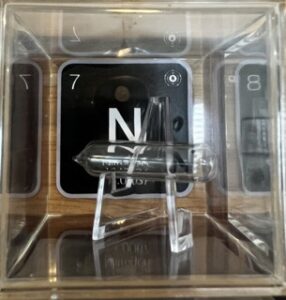Nitrogen
Atomic Number: 7
Atomic Mass: 14.0067 u

In the grand table of the periodic table, nitrogen might not seem as glamorous as gold or as notorious as uranium. Yet, this unassuming element, denoted by the symbol N and atomic number 7, plays an incredibly versatile and vital role in our world. From the air we breathe to the food we eat, nitrogen’s presence is ubiquitous yet often overlooked. In this blog post, we’ll explore the fascinating world of nitrogen and its myriad of uses in modern society.
A Brief History
Nitrogen was discovered in 1772 by Scottish physician Daniel Rutherford, although it was also studied around the same time by other chemists like Carl Wilhelm Scheele and Henry Cavendish. Initially referred to as “noxious air” or “fixed air,” the name nitrogen was derived from the Greek words ‘nitron’ and ‘genes,’ meaning “niter-forming,” a reference to its discovery from niter.
Nitrogen in Nature
Making up about 78% of the Earth’s atmosphere, it is the most abundant uncombined element in the air. It’s as essential for life as oxygen and is a key component of amino acids, proteins, and nucleic acids, including DNA and RNA. However, despite its abundance, most organisms cannot use atmospheric nitrogen directly. It must first be ‘fixed’ into a biologically usable form, a process primarily performed by certain bacteria.
Industrial and Agricultural Uses
Fertilizers
One of the most significant uses of nitrogen today is in the production of ammonia for fertilizers. The Haber-Bosch process, developed in the early 20th century, revolutionized agriculture by allowing the mass synthesis of ammonia from atmospheric nitrogen and hydrogen. This process helped to dramatically increase crop yields and support a growing global population.
Cryogenics
Liquid nitrogen, at a chilly -196°C, is widely used as a coolant. Its applications range from preserving biological samples and food freezing to cryotherapy in medicine and the removal of skin abnormalities.
Industrial Applications
In industries, nitrogen gas is used for creating an inert atmosphere. It’s essential in processes where oxidation needs to be prevented, such as in the manufacture of electronic parts like transistors and diodes, and in the annealing of stainless steel and other metals.
Everyday Uses
Food and Beverage Industry
Nitrogen finds its way into our kitchens too. It’s used in food packaging to preserve freshness by displacing oxygen, thus slowing down spoilage and rancidity. In the beverage industry, nitrogen is used to give a smooth, creamy texture to beers and coffees.
Pharmaceuticals
In pharmaceuticals, nitrogen is used in the production and packaging of medicines to prevent oxidation and degradation.
Environmental Impact
Interestingly, the large-scale production of nitrogen fertilizers and their intensive use in agriculture have significant environmental impacts. It can lead to water pollution and contribute to greenhouse gas emissions. Therefore, managing nitrogen use effectively and sustainably is a critical environmental challenge.
Conclusion: A Versatile Element
From sustaining life to advancing technology, nitrogen’s roles are as varied as they are vital. It’s a cornerstone in agriculture, a stalwart in industry, and an unseen protector in food preservation. This often-overlooked element is indeed a fundamental building block in the intricate puzzle of our planet’s ecosystem and human civilization.
As we continue to explore and understand the various facets of nitrogen, it becomes clear that this element, far from being just another component of the air we breathe, is a dynamic and indispensable contributor to many facets of modern life.
For Kids
Hey kids! Ready to dive into the cool and exciting world of nitrogen? This element is not just a part of the air we breathe; it has some amazing secrets. Let’s explore some fun facts about nitrogen that will make you see this gas in a whole new light!
- Super Abundant!
- Makes up about 78% of the Earth’s atmosphere. That’s a lot! It’s like if you had 100 balloons, 78 of them would be filled with nitrogen.
- Invisible and Odorless
- You can’t see or smell nitrogen. It’s like a ninja, hiding in plain sight all around us!
- Essential for Life
- Is a big deal for all living things. Plants need it to grow, and it’s a crucial part of our DNA, which is like the blueprint for our bodies.
- Lightning’s Magic Trick
- During a thunderstorm, lightning can actually make nitrogen in the air turn into a form that plants can use. It’s like nature’s magic show!
- Freezing Cool!
- Liquid nitrogen is super cold, at about -320°F (-196°C). It’s used to freeze foods quickly and to make cool science experiments, like making instant ice cream or creating a cloud of fog.
- Not Just for Plants
- Nitrogen is also used to fill the tires of race cars and airplanes. It keeps the tires stable, even at high speeds and temperatures.
- A Helping Hand in Space
- Nitrogen helps astronauts breathe in space! It’s mixed with oxygen in space stations and spacecrafts to create an environment similar to Earth’s.
- A Party Trick
- Nitrogen is used in balloons too, but not the kind that float. It fills the balloons that stay on the ground, making them safer than helium balloons.
- A Star Ingredient
- Believe it or not, nitrogen is also found in stars and even in some of the foods we eat!
- An Ancient Discovery
- Nitrogen was discovered over 200 years ago, in 1772, by a Scottish chemist named Daniel Rutherford. He called it “noxious air” at first!
So, there you have it – nitrogen is not just another element; it’s a superhero of the natural world, playing a vital role in everything from the air we breathe to the food we eat and even beyond our planet. Isn’t science amazing? 🌟🌱🚀
 using WordPress and
using WordPress and
No responses yet